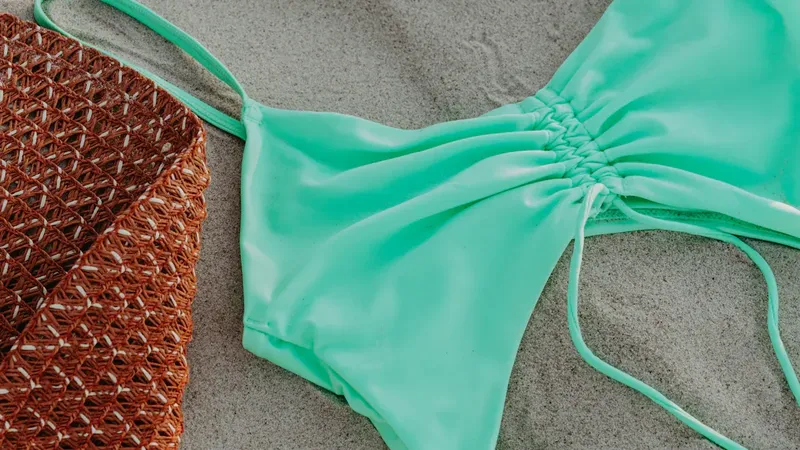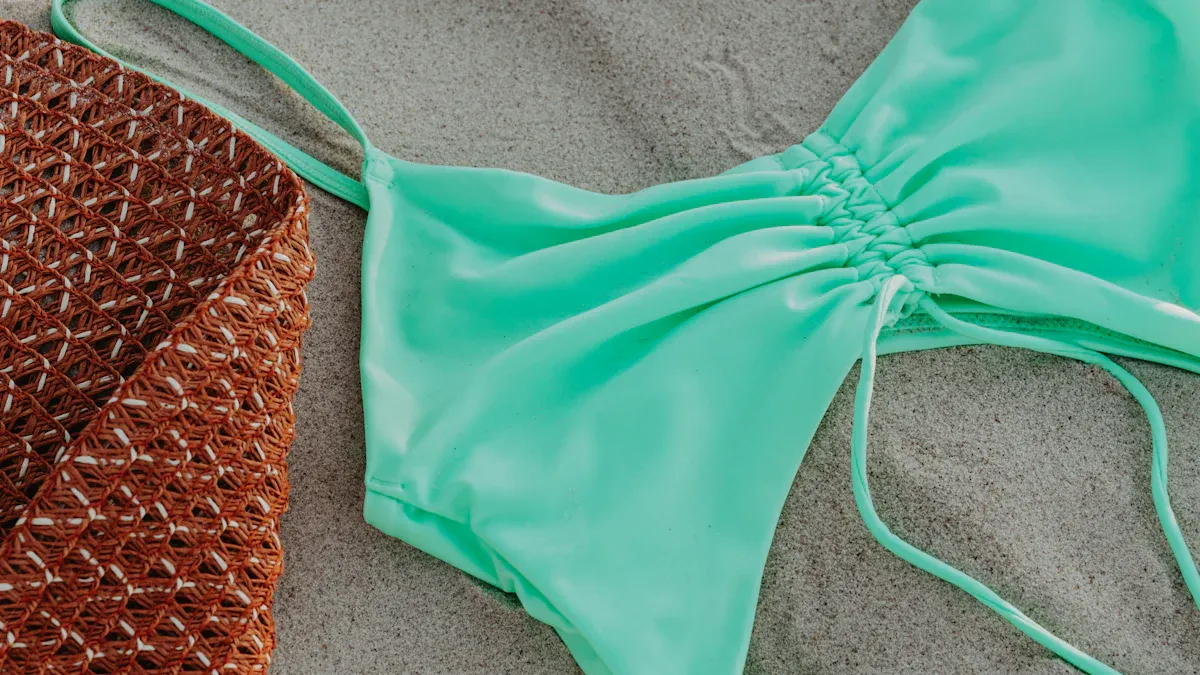
Die neuesten Änderungen bei Bademoden stoffen verändern den Markt für Bade bekleidung schnell. Diese Innovationen treiben die Nachfrage nach umwelt freundlicher, leistungs starker und anpassbarer Bade bekleidung an. Diese Verschiebung betrifft sowohl die Verbraucher als auch jeden Hersteller von kunden spezifischer Bade bekleidung.
Benutzer definierte Bade bekleidungs hersteller integrieren jetzt recycelte Materialien, fortschritt liches Computer design und innovative Produktions techniken. Diese Bemühungen zielen darauf ab, Bade bekleidung zu schaffen, die länger hält und umwelt bewusster ist. Die Trends bei kunden spezifischen Bade bekleidungs herstellern stimmen eng mit den Verbraucher werten überein. Diese neuen Ansätze helfen Kunden, Bade bekleidung zu finden, die sowohl gut gemacht als auch funktional ist.
Aspekt | Details |
|---|---|
Markt größe (2023) | |
Projizierte Größe (2030) | 36,150,5 Mio. USD |
Nylon/Polyester-Anteil (2025) | 54,8% |
Wichtige Wachstums treiber | Stoff innovationen, Nachhaltig keit |
Wichtige Imbiss buden
Neue Bademoden stoffe verwenden recycelte und pflanzliche Materialien. Diese helfen, die Umwelt zu schützen. Sie geben auch Komfort und halten lange.
Fortschritt liche Stoff technologien geben UV-Schutz und trocknen schnell. Sie widerstehen Chlor und behalten ihre Form. Dadurch hält Bade bekleidung länger.
Smart Swimwear verfügt über Sensoren und KI-Coaching. Diese helfen Schwimmern zu verfolgen, wie sie sich fühlen und sich wohl fühlen.
Kunden spezifische Bademoden herstellerVerwenden Sie umwelt freundliche Möglichkeiten, um Anzüge herzustellen. Sie verwenden Zertifizie rungen und faire Arbeit. Dies hilft, hochwertige und nachhaltige Anzüge herzustellen.
Neue Ideen wie 3D-Druck und Digitaldruck helfen bei der Herstellung von benutzer definierter Bade bekleidung. Diese lassen die Menschen stilvolle Anzüge bekommen, die gut passen und besser für den Planeten sind.
Nachhaltige Bade bekleidung Stoffe
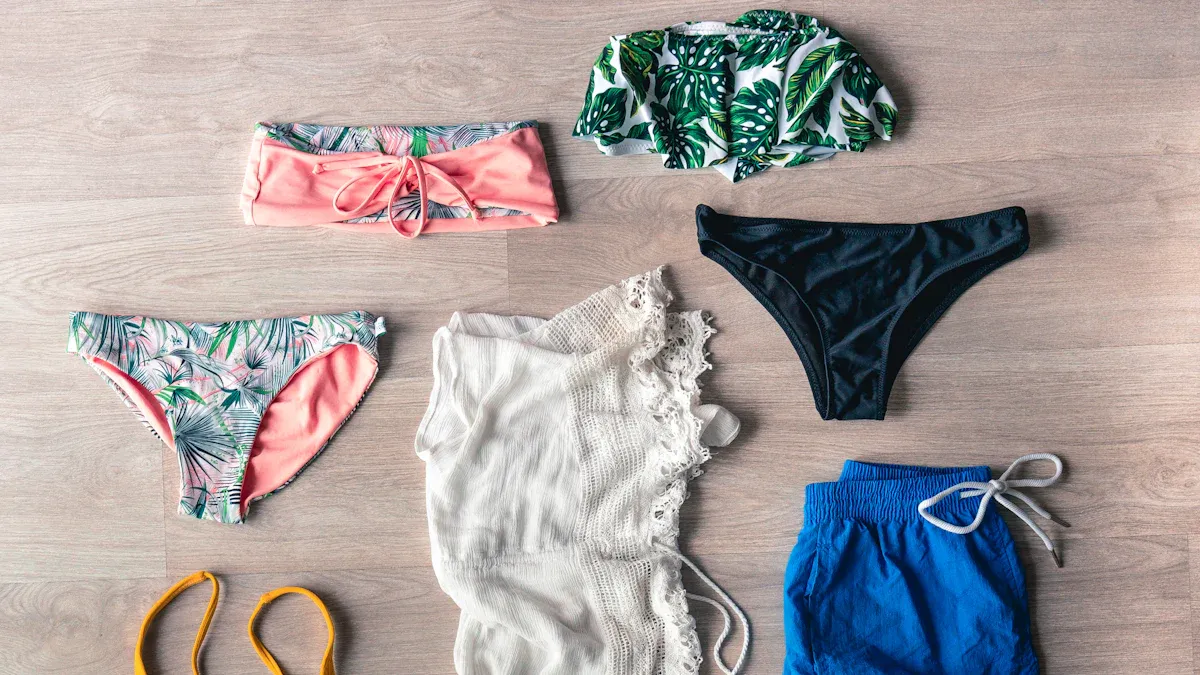
Recycelte Materialien
Viele Marken verwenden heute recycelte Materialien für Bade bekleidung. Das hilft der Umwelt. ECONYL und REPREVE sind zwei beliebte Entscheidungen. ECONYL wird aus Dingen wie alten Fischernetzen und Teppichen hergestellt. Es verwandelt Abfall in starkes Nylon. Dieses Nylon ist genauso gut wie normales Nylon. REPREVE kommt aus Plastik flaschen und alten Kleidern. Es macht Polyester, das sich schnell dehnt und trocknet. Es schützt auch vor der Sonne. Diese Stoffe helfen, die Ozeane sauber zu halten. Sie reduzieren auch Müll auf Müll deponien. Sie funktionieren gut für Bade bekleidung.
Wenn Menschen recycelte Bade bekleidung auswählen, helfen sie dem Planeten. Sie bekommen immer noch Komfort, Stil und langlebige Bade bekleidung.
Stoff | Quell material | Leistung im Vergleich zu traditionellen | Wichtige Leistungs merkmale | Umwelt vorteile |
|---|---|---|---|---|
ECONYL | Recyceltes Nylon aus Fischernetzen, Stoff resten, Teppich abfällen | Matches jungfräuliches Nylon in Qualität und Eigenschaften | Resistent gegen Chlor, UV-Strahlen; langlebig; endlos recycelbar ohne Qualitäts verlust | Reduziert Meeres abfälle; recycelbar; senkt den CO2-Fußabdruck |
VERRINGERN | Recyceltes Polyester aus Plastik flaschen und Textil abfällen | Übereinstimmungen mit traditionellem Polyester | Haltbar; bietet Stretch, UV-Schutz, schnell trocknend | Reduziert die Plastik verschmutzung; senkt die Kohlenstoff emissionen; rück verfolgbare Zertifizierung |
REPREVE nutzt die FiberPrint-Technologie. Dies hilft, die Qualität zu verfolgen und zu überprüfen. Es stellt sicher, dass Bade bekleidung von hoher Qualität bleibt. ECONYL und REPREVE sind gut für die Erde. Sie helfen, Bade bekleidung für die Umwelt besser zu machen.
Pflanzen basierte Optionen
Pflanzliche Bademoden stoffe sind eine weitere grüne Wahl. Diese verwenden Pflanzen, die immer wieder wachsen. Sie brauchen weniger Wasser und weniger Chemikalien. Einige gebräuchliche Pflanzen fasern sind Flachs, Hanf, Baumwolle, Banane, Lotusblume, Feigen kaktus und Seacell. Viele davon brechen natürlich zusammen. Sie sind stark und bekämpfen Keime. Das macht sie großartig für Bade bekleidung.
Pflanzliche Faser | Anbau & Klima | Verwendung in Bade bekleidung/Textilien | Umwelt vorteile |
|---|---|---|---|
Flachs (Leinen) | Cooles gemäßigtes Klima | Atmungsaktive, feuchtigkeit abwickende Textilien | Biologisch abbaubar, langlebig, geringe Umwelt belastung |
Hanf | Gemäßigte Zonen | Bekleidung, anti bakterielle, langlebige Stoffe | Schnell erneuer bar, minimal Wasser, keine synthetischen Düngemittel |
Baumwolle | Warmes Klima | Weichheit, Atmungsaktiv ität in Mischungen | Biologisch abbaubare, nachhaltige Praktiken reduzieren den Einsatz von Wasser und Pestiziden |
Bananen fasern | Tropische Regionen | Leichte, langlebige Textilien | Hergestellt aus landwirtschaft lichen Abfällen, biologisch abbaubar, wasser beständig |
Lotusblume | Tropisch/sub tropisch | Luxus, atmungsaktive, weiche Stoffe | Anti bakterielle, nachhaltige Extraktion, biologisch abbaubar |
Stachelige Birne | Arid/semi-arid | Vegane Leder alternativen, Mischungen | Minimales Wasser, keine Pestizide, biologisch abbaubar, nachhaltig |
See zelle | Küsten-/sub tropisch | Active wear, Wellness-Textilien | Biologisch abbaubare, anti oxidative, umwelt freundliche Produktion |
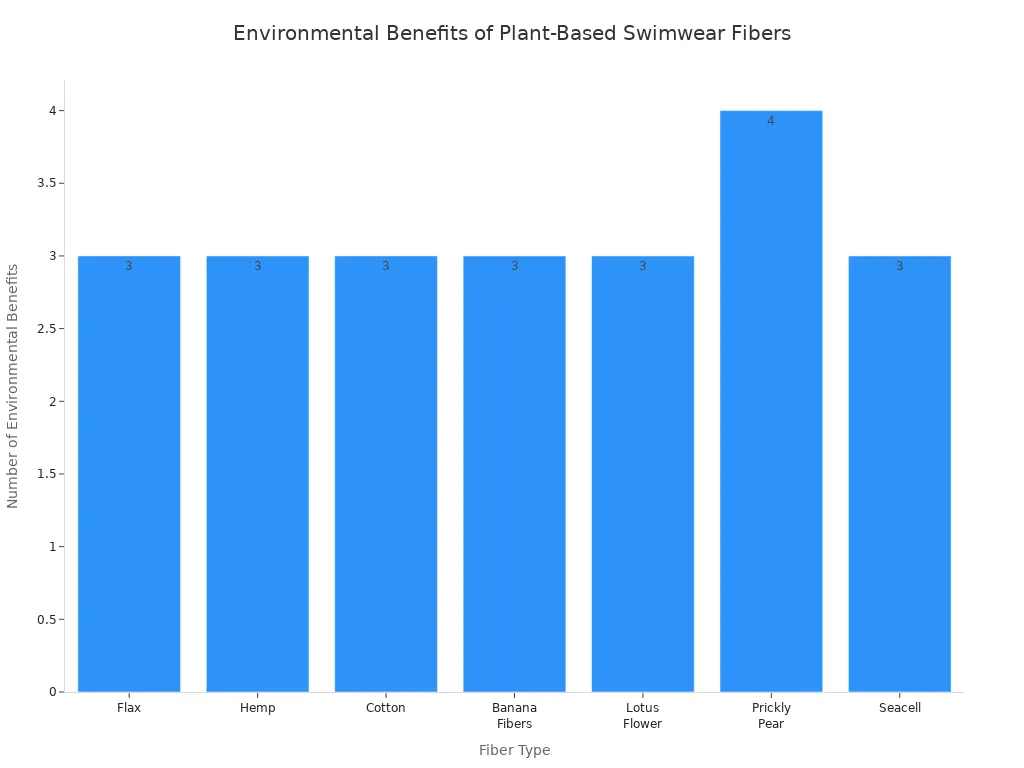
Diese Pflanzens toffe vermischen sich oft mit Elasthan. Dies gibt Bade bekleidung die Dehnung, die sie braucht. Die Verwendung pflanzlicher Stoffe hilft Marken, umwelt freundlichere Entscheidungen zu treffen. Es hilft auch, den Planeten zu schützen.
Biologisch abbaubare Lösungen
Biologisch abbaubare Bademoden stoffe helfen, die Verschmutzung durch Mikro plastik zu stoppen. Amni Soul Eco ist ein besonderes Garn. Es bricht in etwa fünf Jahren zusammen. Es verwandelt sich in natürliches Zeug und Gas. Regelmäßige synthetische Stoffe halten viel länger. Sie können Ozeane für viele Jahre verschmutzen. Recycelte Kunststoffe wie ECONYL und REPREVE helfen, Abfall zu reduzieren. Aber sie werfen immer noch winzige Kunststoff fasern ab.
Naturfasern wie Hanf und Baumwolle brechen schneller ab. Sie brauchen oft Elasthan für die Dehnung. Dadurch können sie weniger zusammenbrechen. Biologisch abbaubare Bademoden stoffe brechen schnell zusammen. Sie sind eine gute Wahl für Menschen, die sich um die Erde kümmern.
Anmerkung:Mehr Bade bekleidungs marken verwenden jetzt Zertifizie rungen. Dazu gehören GOTS, Oeko-Tex 100, Fair Trade und B-Corp. Diese zeigen, dass Bade bekleidung strenge Regeln für den Planeten und die Menschen erfüllt. Zertifizie rungen helfen Käufern, umwelt freundliche Bade bekleidung zu finden. Sie unterstützen auch Marken, die sich um die Erde kümmern.
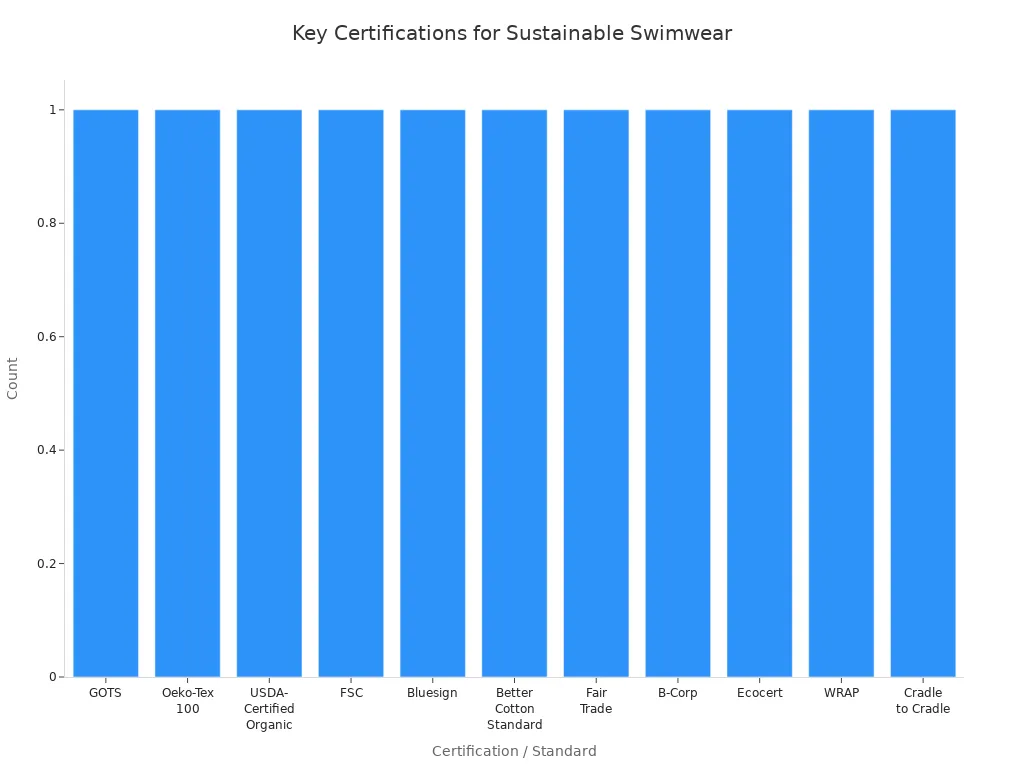
NachhaltigBademode markenWollen, dass ihre Produkte von Dauer sind. Sie bieten Reparatur-und Recycling programme an. Dies hilft, Abfall zu reduzieren. Die Auswahl zertifizierter und nachhaltiger Stoffe hilft Menschen und Unternehmen, den Planeten zu schützen.
Neueste Bade bekleidung Stoff technologien
Neue Bademoden-Stoff technologien haben die Funktions weise von Badeanzügen verändert. Marken verwenden jetzt spezielle Mischungen und Behandlungen, um Schwimmern und Menschen am Strand zu helfen. Diese neuen Ideen machen Bade bekleidung auch nach vielen Tragen bequemer, stärker und stilvoller.
UV-Schutz
UV-Schutz ist in der heutigen Bade bekleidung sehr wichtig. Viele Marken verwenden Polyester mit PBT, um Stoffe herzustellen, die die Sonne blockieren. Tests zeigen, dass PBT-Polyester-MischungenUPF-Bewertungen von 25 bis 39. Dies bedeutet, dass sie die meisten schädlichen Strahlen stoppen und Ihre Haut in der Sonne schützen. Diese Mischungen behalten auch ihre Form, trocknen schnell und werden auch nach viel Zeit in Pools nicht durch UV-Strahlen beschädigt.
Polyester nimmt nicht viel Wasser auf und schützt so die Fasern vor Chlor und UV-Strahlen.
Einige Stoffe, wie dope-gefärbtes Polyester mit XLANCE®Technologie, halten ihre Farbe und Stärke, die mit UV-Schutz hilft.
PBT-Polyester gewebeSind das Beste für den UV-Schutz, basierend auf Tests.
Bade bekleidung mit diesen Funktionen hilft Schwimmern, sich sicher zu fühlen und Sonnenbrand zu vermeiden. Um die beste Bade bekleidung auszuwählen, suchen Sie nach hohen UPF-Bewertungen und Materialien, die Chlor und UV-Strahlen widerstehen.
Schnell trocknungs funktionen
Schnell trocknende Bade bekleidung macht das Tragen bequemer und einfacher. Neue Bademoden stoffe verwenden Mischungen, die schnell trocknen und sich leicht anfühlen. Nylon mischungen, normaler weise80% Nylon und 20% Elasthan, Sind weich, dehnbar und leiten Feuchtigkeit ab. Diese Mischungen trocknen schnell, so dass sie gut für Mode-Bade bekleidung sind. Aber Nylon kann bei starkem Sonnenlicht verblassen und abnutzen.
Polyester mischungen, oft mit 10-20% Elasthan, werden in Renn bade bekleidung verwendet. Sie trocknen schnell, widerstehen Chlor-und UV-Strahlen und behalten ihre Form. Eine gemeinsame Mischung ist85% Polyester und 15% ElasthanDies bietet schnelles Trocknen, Festigkeit, Dehnung und UV-Schutz.
Trocknungs geschwindigkeit | Hauptmerkmale | Profis | Nachteile | |
|---|---|---|---|---|
Nylon mischungen | Effiziente Schnell trocknung | Weich, dehnbar, leicht, UV-beständig | Atmungsaktiv, weich, bequem, langlebig | Falten leicht, schwach zum Licht |
Polyester-Mischungen | Schnell zu trocknen | Haltbar, Chlor & UV-beständig, Form retention | Stark, langlebig, flexibel, widersteht dem Schrumpfen | Weniger atmungsaktiv, temperature mpfindlich |
Bikinis aus Nylon mischungen fühlen sich leicht an und lassen Schweiß weg, aber Polyester mischungen halten länger und verblassen nicht so schnell. Der beste Bademoden stoff trocknet schnell und hält Chlor und UV-Strahlen stand.
Chlor beständigkeit
Chlor beständigkeit ist sehr wichtig für Badeanzüge, die in Pools verwendet werden. Regelmäßige Badeanzüge aus Nylon und SpandexVerlieren ihre Form und werden schnell dünnWeil Chlor die elastischen Fasern abbaut. Neue Bade bekleidungs stoffe verwenden Polyester oder PBT, die mit Pool chemikalien umgehen und deren Dehnung und Farbe beibehalten können.
Chlor beständige Bade bekleidung verwendet starke Materialien wie Polyester und PBT, Die länger dauern und nicht durch Chlor ruiniert werden.
Diese Stoffe behalten nach viel Zeit in Chlor ihre Dehnung, leuchtenden Farben und Form, während normale Stoffe verblassen und schwach werden.
Chlor beständige Stoffe schützen auch vor UV-Strahlen, so dass Farben nicht zusammen von Sonne und Chlor verblassen.
Diese Stoffe trocknen schnell, was ihnen hilft, länger zu halten.
Durch diese Merkmale hält Bade bekleidung länger als normale Stoffe.
Die mit diesen guten Materialien hergestellte Bade bekleidung bleibt auch nach vielen Schwimmen hell und stark. Stoffe, die Chlor und UV-Strahlen widerstehen, helfen Schwimmern, ihre Anzüge länger zu benutzen und weniger Abfall zu machen.
Form rückhalt ung
Form retention bedeutet, dass Bade bekleidung nach vielen Tragen gut passt. Neue Stoff behandlungen, wieWasser abweisende und anti mikrobielle OberflächenHelfen Sie, Bade bekleidung länger zu halten und bequem zu bleiben. Wasser abweisende Oberflächen helfen Bade bekleidung, schnell zu trocknen, und verhindern, dass sie Wasser aufsaugt, das ihre Form behält. Anti mikrobielle Behandlungen stoppen Keime und schlechte Gerüche, so dass der Stoff frisch bleibt.
Polyester gewebe hält Chlor stand, Behält seine Form und Dehnung nach vielen Wäschen und schützt vor UV-Strahlen.
Spandex (Lycra oder Elastan) gibt große Dehnung und Sprungkraft zurück. Marken mischen es mit Polyester oder Nylon, um mehr Dehnung und Form zu halten.
PBT-Stoff verleiht eine große Chlor beständigkeit und behält seine Form, ohne zu viel zu quetschen.
Zu den Qualitäts prüfungen gehören Stretch tests, um sicher zustellen, dass die Stoffe nach vielen Verschleiß ihre Form behalten.
LYCRA XTRA LEBEN®Faser ist ein spezielles Spandex, das nicht durch Chlor, UV-Strahlen, Hitze, Sonnencreme oder Körper öle beschädigt wird. EsBehält seine Passform und Form bis zu 10-mal längerAls andere Fasern. Sowohl Labor-als auch Pool tests zeigen, dass es mit schwierigen Bedingungen umgehen kann, sodass es nicht an Passform verliert oder bricht. Diese Eigenschaften machen es zu einer Top-Wahl für Sport bademode.
Tipp: Suchen Sie beim Auswählen von Bade bekleidung nach Mischungen, die sich dehnen und ihre Form behalten, Chlor-und UV-Strahlen widerstehen und gute Materialien verwenden. Diese Funktionen helfen Bade bekleidung, länger zu halten und besser zu funktionieren.
Die neuesten Bademoden-Stoff technologien konzentrieren sich auf Leistung, Komfort und Stärke. Durch die Verwendung neuer Mischungen und Behandlungen stellen Marken Bade bekleidung her, die für aktive Schwimmer und Menschen geeignet ist, die sich für Stil interessieren. Das Auswählen des besten Bade bekleidungs stoffes bedeutet, UV-Schutz, schnelles Trocknen, Chlor-und UV-Beständigkeit sowie eine hervorragende Stretch-und Form haltung zu suchen.
Intelligente und funktionelle Bademode
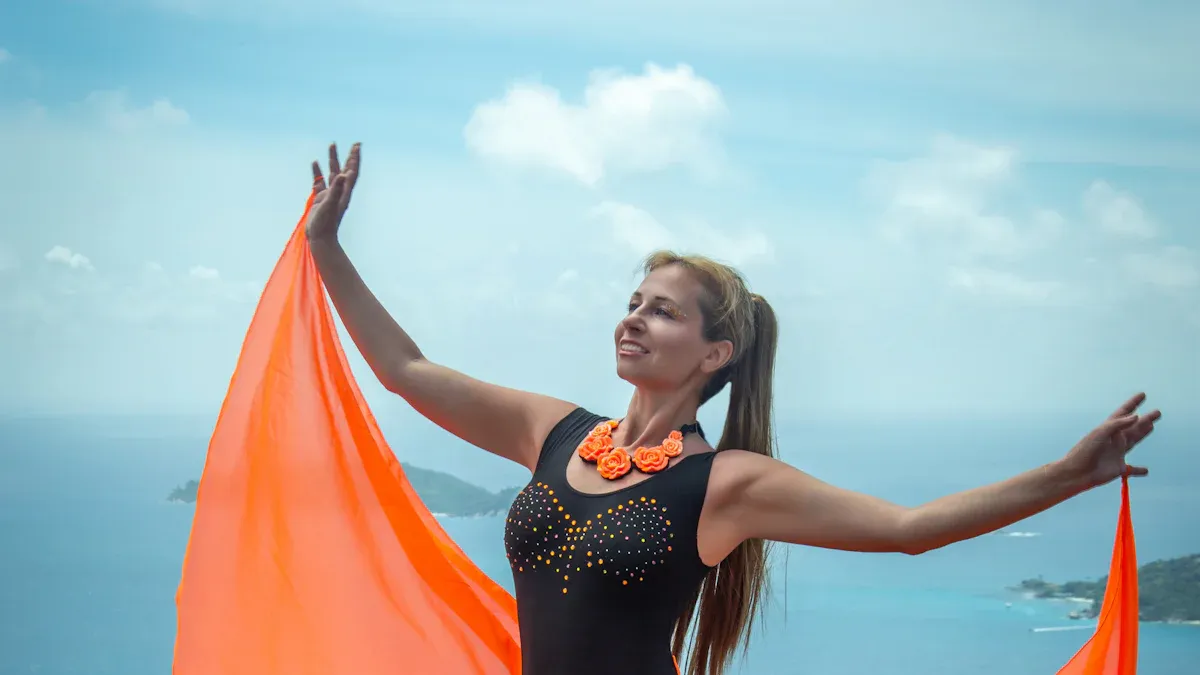
3D-Druck
3D-DruckHat sich verändert, wie Bade bekleidung hergestellt wird. Designer verwenden Software wieBrowzwear's VStitcherUm zu sehen, wie Stoff auf ein Computer modell passt. Sie können Muster, Farben und Zlenden ändern, bevor sie echte Samples erstellen. Dadurch wird das Entwerfen schneller und genauer. Jetzt können Designer machenCustom Bademode für jede Person. Mit dem 3D-Druck können sie neue und besondere Stile erstellen. Marken scannen den Körper einer Person, um Bade bekleidung herzustellen, die gut passt und sich gut anfühlt. Dies hilft den Menschen, Bade bekleidung zu bekommen, die nur für sie ist. Es macht auch Bade bekleidung bequemer und besser zum Schwimmen.
Adaptive Designs
Adaptive BademodeHilft allen Körper typen, sich gut und selbst bewusst zu fühlen. Marken verwenden weiche, dehnbare Stoffe und Funktionen wie Gurte, die Sie anpassen können.Magnetische VerschlüsseUnd Tassen, die Sie herausnehmen können. Diese Dinge helfen jedem, einen Anzug zu finden, der gut passt. Einige Badeanzüge haben UPF 50 + Schutz und arbeiten mit Prothesen. Andere kommen hereinGeschlechts neutrale Stile und Größen von XS bis 6X. Marken wie Eloquii, Unika und ChromatKonzentrieren Sie sich auf Unterstützung, Bauch kontrolle und einfache Verschlüsse. Die folgende Tabelle enthält einige Beispiele:
Bademode Stil | Adaptive Merkmale | Fit & Komfort verbesserungen |
|---|---|---|
Einteiliger Badeanzug | Prothesen freundlich, UPF50 Schutz | Weich, Bildhauerei, Abdeckung möglichkeiten |
Zweiteiler (klassisch) | Inklusives Design, verstellbare Passform | Bewegungs freundliche, elegante Passform |
Unterteil mit hoher Taille | Sculpting Schnitt, hohe Taille Unterstützung | Komfort, schmeichel hafte Silhouette |
Tankini-Sets | Verstellbare Ober-und Unterteile | Anpassbare Passform, Abdeckung Optionen |
Diese Eigenschaften machen Bade bekleidung bequemer und einfacher für alle zu tragen.
Integrierte Technik
Smarte Bade bekleidungNutzt jetzt neue Technologien, um Schwimmern zu helfen, es besser zu machen. Einige Anzüge verwenden spezielle Stoffe, die schnell trocknen, UV-Strahlen blockieren und den Muskeln helfen. Andere Anzüge haben Sensoren, die Herzfrequenz, Schlaganfälle und Geschwindigkeit verfolgen. Diese Sensoren senden Daten an Apps, damit Schwimmer sehen können, wie es ihnen geht. KI-Tracking gibt Tipps und Coaching basierend darauf, wie Sie sich bewegen. Einige intelligente Anzüge überprüfen sogar, ob Sie Wasser benötigen oder ob Ihr Körper zu heiß oder zu kalt ist.
Integrierte Technologie | Beschreibung und Vorteile |
|---|---|
Schnell trocknung, UV-Schutz, Muskel kompression für bessere Durchblutung und weniger Müdigkeit | |
Eingebettete Sensoren | Verfolgen Sie Herzfrequenz, Atmung, Schlaganfall zahl und Geschwindigkeit. Geben Sie Echtzeit-Feedback |
KI-betriebene Tracking | Personal isiertes Coaching und Tipps basierend auf Bewegung |
Bluetooth-Konnektivität | Verbindet sich mit Apps und Geräten für weitere Informationen |
Hydratation/Temperatur sensoren | Überprüfen Sie die Flüssigkeits zufuhr und die Körper temperatur auf eine bessere Gesundheit |
Diese intelligenten Funktionen helfen Schwimmern, besser zu trainieren, bequem zu bleiben und ihr Bestes zu geben.
Innovative Stoffe und Texturen
Jacquard und gerippt
Jacquard und gerippte StoffeSind jetzt sehr beliebt in Bade bekleidung. Jacquard stoffe haben ausgefallene Muster, die durch eine spezielle Web methode hergestellt werden. Diese Muster lassen Badeanzüge interessant und handgemacht aussehen. Viele Jacquard stoffe verwendenBio-Baumwolle, Die weich für empfindliche Haut und besser für die Erde ist. Sie lassen Luft durch, ziehen den Schweiß weg und blockieren etwas Sonne, aber sie trocknen möglicher weise langsamer als andere Stoffe. Der gerippte Look in Jacquard fügt Schichten und einen klassischen Stil hinzu.
Gerippte Bademoden stoffeWerden aus gerippten Jersey-Strickwaren hergestellt. Sie haben Linien angehoben, die auf und ab gehen. Dadurch dehnt sich der Stoff mehr und fühlt sich dicker an, lässt aber trotzdem Luft herein. Gerippte Stoffe behalten ihre Form und fühlen sich gut an. Designer verwenden gerippte matte Strickwaren, um Badeanzüge herzustellen, die schick und natürlich aussehen. Diese Texturen passen zu Stilen, die verwendenErde farben und schichtenUnd gibt jedem Stück ein besonderes Gefühl.
Digitaldruck
DigitaldruckHat sich verändert, wie Marken Muster auf Bade bekleidung setzen. Diese Methode verwendetTinten strahl oder SublimationZum DruckenHelle, klare DesignsDirekt auf dem Stoff. Polyester-Mischungen, Die sich hervorragend für Bade bekleidung eignen, nehmen Sie den Farbstoff gut auf und werden Sie nicht durch Chlor oder die Sonne ruiniert. Der Digitaldruck macht Muster, die auch nach dem Schwimmen oder in der Sonne hell und scharf bleiben. Neue Regeln sorgen dafür, dass bedruckte Stoffe ihre Farbe behaltenUnd lange dauern. Marken können jetzt benutzer definierte Designs erstellen, die detailliert sind und bunt bleiben.
Mit dem Digitaldruck können Marken Badeanzüge mit coolen, starken Drucken herstellen, die am Pool oder Strand großartig aussehen.
Anpassungs trends
Jetzt,Unternehmen lassen Leute Badeanzüge bekommen, die nur für sie gemacht wurden. Marken arbeiten mit Herstellern zusammen, um Badeanzüge zu kreieren, die den Wünschen jeder Person entsprechen und dennoch eine gute Qualität haben. Viele Badeanzüge haben Dinge wieRiemen, die Sie wechseln können, Pads, die Sie herausnehmen können, zweiseitige Stile und schnell trocknende Stoffe. Diese Eigenschaften lassen Badeanzüge besser aussehen und besser funktionieren. Benutzer definierte Optionen bedeuten auch mehr Größen und spezielle Dekorationen, sodass jeder einen passenden Anzug finden kann.
Print-on-Demand-Bade bekleidungLässt Designer besondere Stücke herstellen, ohne zu viele zu machen.
Umwelt freundliche Stoffe und Möglichkeiten, beim Färben Wasser zu sparen, sind gut für Käufer, die sich für den Planeten interessieren.
Benutzer definierte Badeanzüge passen zu allen Körper typen und persönlichen Stilen.
Dieser Fokus auf neue Stoffe, cooles Drucken und individuelle Auswahl hält Bade bekleidung Spaß, bequem und anders.
Kunden spezifische Bademode Hersteller Trends
Annahme der Industrie
Kunden spezifische Bademoden hersteller sind führend in der Verwendung neuerUmwelt freundliche StoffeUnd Technologie. Viele Unternehmen nutzen inzwischenRecycelte Stoffe wie ECONYL und REPREVE. ECONYL wird aus Fischernetzen und Plastikmüll hergestellt. Dies hilft, die Ozeane sauberer zu halten und die Verschmutzung durch die Herstellung von Nylon um bis zu 90% zu verringern. REPREVE verwandelt alte Plastik flaschen in starke Fasern. Dies macht Bade bekleidung, die sowohl gut für den Planeten als auch von hoher Qualität ist. Einige Hersteller wählen auch organische und biologisch abbaubare Stoffe. Diese brechen schneller zusammen und machen mit der Zeit weniger Abfall.
Hersteller kümmern sich darum, wie ihre Produkte hergestellt werden. Sie sorgen dafür, dass die Arbeitnehmer sichere Arbeits plätze und eine faire Bezahlung haben. Zertifizie rungen wie GOTS und OEKO-TEX zeigen, dass Stoffe organisch und sicher vor schädlichen Chemikalien sind. Marken wie Tideline Swimwear und Summers alz verwenden recycelte Materialien und bieten viele Größen. Diese Unternehmen versuchen, Bade bekleidung herzustellen, die hält, erschwing lich ist und besser für die Erde ist.
Aspekt | Beschreibung |
|---|---|
Recycelte Stoffe | ECONYL: Hergestellt aus Fischernetzen, Stoff resten und Plastikmüll; hilft Ozeanen und reduziert die Umwelt verschmutzung durch Nylon um bis zu 90%. |
REPREVE: Verwandt Plastik flaschen in starke, hochwertige Fasern, die gut für den Planeten sind. | |
Organisch und biologisch abbaubar | Verwendet natürliche Stoffe, die schneller zerfallen und weniger Abfall machen. |
Ethische Fertigung | Stellen Sie sicher, dass die Arbeitnehmer fair behandelt werden und an sicheren Orten arbeiten. |
Zertifizie rungen | GOTS beweist, dass Stoffe organisch sind; OEKO-TEX zeigt, dass sie vor schlechten Chemikalien sicher sind. Kontrollen durch Dritte machen diese Behauptungen stärker. |
Vermeidung von Schädlichen Chemikalien | Unternehmen verwenden keine giftigen Farbstoffe oder Chemikalien. Sie wählen sicherere Wege, um Bade bekleidung zum Schutz von Menschen und Natur herzustellen. |
Marken beispiele | Marken wie Tideline Swimwear und Summers alz verwenden recycelte Materialien, stellen starke Anzüge her und bieten viele Größen zu guten Preisen an. |
Nachhaltige Praktiken
Kunden spezifische Bademoden herstellerVerwenden Sie grüne Praktiken in verschiedenen Teilen der Welt. In Nordamerika verkaufen Marken sowohl ausgefallene als auch billigere Bade bekleidung aus umwelt freundlichen Materialien. Europa hat eine große Nachfrage nach Bade bekleidung, die auf faire und grüne Weise hergestellt wird. Das macht Nachhaltig keit dort sehr wichtig. Der asiatisch-pazifische Raum und Latein amerika wachsen schnell und mehr Menschen wollen umwelt freundliche Bade bekleidung. Der Nahe Osten und Afrika wachsen ebenfalls, aber die Sorge um die Umwelt ist dort nicht so groß.
Region | Nachhaltige Praktiken und Markt merkmale |
|---|---|
Nordamerika | In diesem Bereich möchten viele Menschen sowohl luxuriöse als auch erschwing liche Bade bekleidung aus grünen Materialien. Marken wie die Adidas AG stellen Hoch leistungs anzüge mit umwelt freundlichen Stoffen her. Grüne Praktiken sind aufgrund starker Regeln und eines reifen Marktes üblich. |
Europa | Das Wachstum ist stetig, weil die Menschen umwelt freundliche und faire Bade bekleidung wünschen. Käufer fragen nach grünen Entscheidungen, daher ist dies ein wichtiger Grund für Wachstum. |
Asien-Pazifik | Dieses Gebiet wächst schnell, da die Städte größer werden und die Menschen mehr verdienen. Grüne Praktiken sind noch nicht so üblich, aber mehr Menschen wollen sie. |
Latein amerika | Das Wachstum ist stabil, unterstützt durch den Tourismus und mehr Geld. Bei der Herstellung von Bade bekleidung wird nicht so viel Wert auf grüne Praktiken gelegt. |
Naher Osten & Afrika | Das Wachstum ist stetig mit mehr Touristen und der Nachfrage nach ausgefallener Bade bekleidung. Grüne Praktiken sind nicht so wichtig wie an anderen Orten. |
Die Herstellung umwelt freundlicher Bade bekleidung kostet mehr. Dies liegt daran, dass organische Materialien und faire Bezahlung extra kosten. Die Herstellung von weniger Anzügen und die Überprüfung der Qualität trägt ebenfalls zum Preis bei. Obwohl es mehr kostet, halten diese Stoffe länger und schützen besser vor der Sonne. Hersteller verwenden die besten Materialien undNeue Technologie wie 3D-Druck und AI-Design. Sie arbeiten eng mit Lieferanten zusammen und halten mit Zertifizie rungen wie ISO 9001 und BSCI Schritt.
Top-Unternehmen wie AEL Apparel, Bali Swim und Hongyu ApparelDie Messlatte hoch legen. Bali Swim nutzt Solarenergie und gibt Geld, um den Ozean zu retten. Bellakini Bademode konzentriert sich auf die Herstellung umwelt freundlicher Anzüge. Movement MFG und Prototype machen kleine Chargen und lassen die Leute ihre Bade bekleidung anpassen. Diese Unternehmen zeigen, dass sie sich für den Planeten interessieren und folgen den neuesten Bademoden trends.
Hinweis: Kunden spezifische Bade bekleidungs hersteller finden immer wieder neue Möglichkeiten, umwelt freundliche Stoffe zu verwenden. Sie arbeiten hart, um Kosten, Qualität und Pflege der Erde in Einklang zu bringen. Ihre Arbeit verändert die Bade bekleidung und setzt neue Regeln für die Branche.
Neue Änderungen in der Bade bekleidung haben Anzüge stärker gemacht undBesser für den Planeten. Marken nutzenRecycelte Materialien,Smart stoffe, UndNeue technologieUm Menschen zu helfen.
Wirkungs bereich | Key Benefit |
|---|---|
Haltbarkeit | |
Nachhaltig keit | Verwendet grüne Materialien und macht weniger Umwelt verschmutzung |
Leistung | Schützt vor der Sonne, trocknet schnell, fühlt sich bequem an |
Käufer wollen Bade bekleidung, die istGut für die Erde, funktioniert gut und sieht gut aus. Da Marken immer neue Dinge herstellen, wird Bade bekleidung noch besser und persönlicher. Dies wird sich in Zukunft ändern, was Menschen am Strand tragen.
FAQ
Was unter scheidet recycelte Bademoden stoffe von normalen Stoffen?
RecyceltBademode stoffeWerden aus Dingen wie alten Fischernetzen und Plastik flaschen hergestellt. Diese Stoffe helfen, Abfall zu reduzieren und die Umwelt verschmutzung zu stoppen. Sie sind genauso stark und bequem wie normale Stoffe.
Wie funktioniert UV-Schutz in Bademoden stoffen?
UV-SchutzKommt aus speziellen Fasern und Behandlungen im Stoff. Diese blockieren die schädlichen Strahlen der Sonne. Stoffe mit hohen UPF-Bewertungen helfen, Ihre Haut zu schützen und Sonnenbrand zu stoppen.
Sind biologisch abbaubare Bademoden stoffe für empfindliche Haut unbedenklich?
Biologisch abbaubare Bademoden stoffe verwenden oft Naturfasern, die sich weich und sanft anfühlen. Viele Marken testen diese Stoffe, um sicher zustellen, dass sie sicher und bequem für Menschen zu tragen sind.
Tipp: Suchen Sie immer nach Zertifizie rungen wie Oeko-Tex oder GOTS. Diese zeigen, dass die Bade bekleidung sicher und gut für den Planeten ist.
Kann intelligente Bade bekleidung die Schwimm leistung verfolgen?
Intelligente Bade bekleidung verfügt über Sensoren und verwendet spezielle Textilien. Diese Sensoren überprüfen Ihre Herzfrequenz, wie viele Schläge Sie ausführen und Ihre Geschwindigkeit. Schwimmer können ihre Ergebnisse auf Apps sehen, die eine Verbindung zum Anzug herstellen.
Feature | Nutzen |
|---|---|
Sensoren | Verfolgt die Leistung |
AI Coaching | Gibt Feedback |
Schnell trocknende Technik | Verbessert den Komfort |
